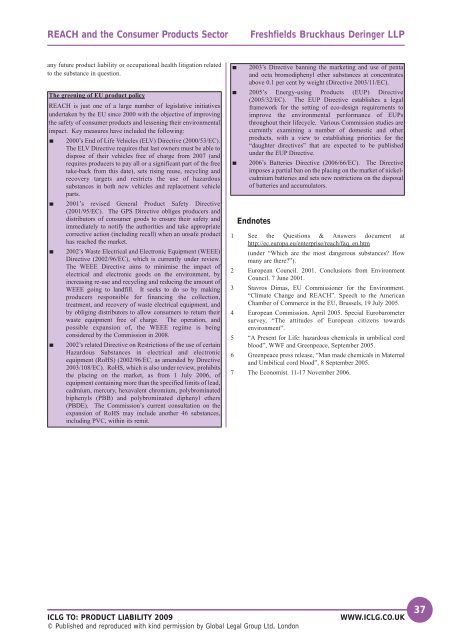Product Liability 2009 - Arnold & Porter LLP
Product Liability 2009 - Arnold & Porter LLP
Product Liability 2009 - Arnold & Porter LLP
Create successful ePaper yourself
Turn your PDF publications into a flip-book with our unique Google optimized e-Paper software.
REACH and the Consumer <strong>Product</strong>s Sector Freshfields Bruckhaus Deringer <strong>LLP</strong><br />
any future product liability or occupational health litigation related<br />
to the substance in question.<br />
The greening of EU product policy<br />
REACH is just one of a large number of legislative initiatives<br />
undertaken by the EU since 2000 with the objective of improving<br />
the safety of consumer products and lessening their environmental<br />
impact. Key measures have included the following:<br />
2000’s End of Life Vehicles (ELV) Directive (2000/53/EC).<br />
The ELV Directive requires that last owners must be able to<br />
dispose of their vehicles free of charge from 2007 (and<br />
requires producers to pay all or a significant part of the free<br />
take-back from this date), sets rising reuse, recycling and<br />
recovery targets and restricts the use of hazardous<br />
substances in both new vehicles and replacement vehicle<br />
parts.<br />
2001’s revised General <strong>Product</strong> Safety Directive<br />
(2001/95/EC). The GPS Directive obliges producers and<br />
distributors of consumer goods to ensure their safety and<br />
immediately to notify the authorities and take appropriate<br />
corrective action (including recall) when an unsafe product<br />
has reached the market.<br />
2002’s Waste Electrical and Electronic Equipment (WEEE)<br />
Directive (2002/96/EC), which is currently under review.<br />
The WEEE Directive aims to minimise the impact of<br />
electrical and electronic goods on the environment, by<br />
increasing re-use and recycling and reducing the amount of<br />
WEEE going to landfill. It seeks to do so by making<br />
producers responsible for financing the collection,<br />
treatment, and recovery of waste electrical equipment, and<br />
by obliging distributors to allow consumers to return their<br />
waste equipment free of charge. The operation, and<br />
possible expansion of, the WEEE regime is being<br />
considered by the Commission in 2008.<br />
2002’s related Directive on Restrictions of the use of certain<br />
Hazardous Substances in electrical and electronic<br />
equipment (RoHS) (2002/96/EC, as amended by Directive<br />
2003/108/EC). RoHS, which is also under review, prohibits<br />
the placing on the market, as from 1 July 2006, of<br />
equipment containing more than the specified limits of lead,<br />
cadmium, mercury, hexavalent chromium, polybrominated<br />
biphenyls (PBB) and polybrominated diphenyl ethers<br />
(PBDE). The Commission’s current consultation on the<br />
expansion of RoHS may include another 46 substances,<br />
including PVC, within its remit.<br />
Endnotes<br />
ICLG TO: PRODUCT LIABILITY <strong>2009</strong><br />
© Published and reproduced with kind permission by Global Legal Group Ltd, London<br />
2003’s Directive banning the marketing and use of penta<br />
and octa bromodiphenyl ether substances at concentrates<br />
above 0.1 per cent by weight (Directive 2003/11/EC).<br />
2005’s Energy-using <strong>Product</strong>s (EUP) Directive<br />
(2005/32/EC). The EUP Directive establishes a legal<br />
framework for the setting of eco-design requirements to<br />
improve the environmental performance of EUPs<br />
throughout their lifecycle. Various Commission studies are<br />
currently examining a number of domestic and other<br />
products, with a view to establishing priorities for the<br />
“daughter directives” that are expected to be published<br />
under the EUP Directive.<br />
2006’s Batteries Directive (2006/66/EC). The Directive<br />
imposes a partial ban on the placing on the market of nickelcadmium<br />
batteries and sets new restrictions on the disposal<br />
of batteries and accumulators.<br />
1 See the Questions & Answers document at<br />
2<br />
http://ec.europa.eu/enterprise/reach/faq_en.htm<br />
(under “Which are the most dangerous substances? How<br />
many are there?”).<br />
European Council. 2001. Conclusions from Environment<br />
Council. 7 June 2001.<br />
3 Stavros Dimas, EU Commissioner for the Environment.<br />
“Climate Change and REACH”. Speech to the American<br />
Chamber of Commerce in the EU, Brussels, 19 July 2005.<br />
4 European Commission. April 2005. Special Eurobarometer<br />
survey, “The attitudes of European citizens towards<br />
environment”.<br />
5 “A Present for Life: hazardous chemicals in umbilical cord<br />
blood”, WWF and Greenpeace, September 2005.<br />
6 Greenpeace press release, “Man made chemicals in Maternal<br />
and Umbilical cord blood”, 8 September 2005.<br />
7 The Economist. 11-17 November 2006.<br />
WWW.ICLG.CO.UK 37





